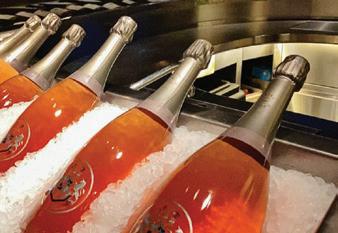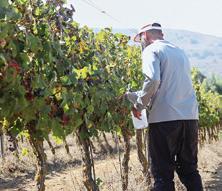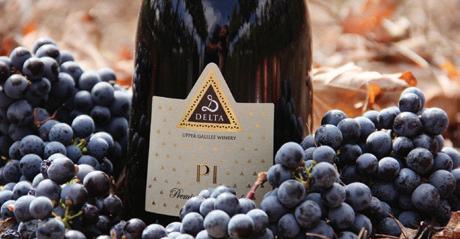
7 minute read
ROSÉ TRENDS
from WineGuide_March2021
by Design2Pro
The Parade of the Rosés
By Dr. Kenneth Friedman
Advertisement
It seems everywhere you look these days, the presence of pink wine is continually growing. Even during a global pandemic that has continued into 2021, sales of rosé have risen and the kosher market will see a greater quantity of rosé in Spring 2021.
And for good reason: Rosé is generally affordable, easy to drink, and universally considered fruity and fun. Virtually every winemaker who makes kosher wine now produces a rosé, hailing from all parts of the world.
How do you like your rosé? Pale, restrained and Provençal? Fruitforward and with more heft? Sweet? Bursting with bubbles? Rest assured, there’s a rosé being produced with you in mind.
Even with the 25% U.S. tariff on French wines taking effect in 2019, French wine imports continue to rise to the United States. Its driver? Rosé. While millennials have not bought wine apace with older generations, they most certainly are responsible for the great boom in kosher rosé sales.
Just a decade ago, many consumers—non-kosher and kosher alike—were unfamiliar with rosé, but with booming growth in all areas of kosher food and wine, it is only natural to expect a parallel phenomenon to occur with the rise of rosé.
“The most noticeable trend of the past five years has been the ascent of rosé wines,” said Gabriel Geller, director of public relations and wide education for Royal Wine Corp. “The constant growth, both in sales and offerings, has shown that it is not a passing trend but a category that is here to stay.”
Geller explained that this trend is good for the market, considering that “the context in which rosé wines are often consumed, typically on a weeknight, [as part of] a simple dinner or as a refreshing and relaxing drink on Shabbat makes it the type of wine that helps to promote wine as a culture in our community, away from the sole obligations of kiddush and other religious ceremonies.”
The kosher wine world will see well over 100 rosé offerings in 2021. “I don’t think we have reached a ceiling yet,” said Geller. The rosé category will not just be composed of entry-level easy-drinkers, but will include several higher-priced French offerings from Château Roubine, which produced three Cotes du Provence rosés last year, but will offer three or four more rosés this year.
A particularly well-received rosé last year was that of Cantina Giuliano, one of only three allkosher wineries in Europe, located in the heart of Tuscany and imported to the United States by Allied Importers, Inc. Produced from 100% Sangiovese, the rosé was a huge hit, selling out quickly.
“The right people, thank God, found my rosé good very early in the season,” owner and winemaker Eli Gauthier told me, “and everybody just kind of followed up on those opinions.”
Gauthier produced 4,000 bottles of rosé last year, and plans to increase to 5,000 bottles this year. “Being a small winery, there’s a bit of mazal to things,” said Gauthier. “I don’t control everything perfectly every day, and wines have a way to just take a direction of their own sometimes.”
As the growing rosé trend intersects with the equally prevalent trend towards all things kosher, wineries everywhere seek a toehold into this world. Importer and distributor The River Wine, managed by Ami and Larissa Nahari, produces the Contessa Annalisa Collection, which sources wines from Italian winemakers.
I asked winemaker Cristian Tombacco, producer of the 2020 Contessa Annalisa rosé, what he aims for when producing rosé for the American kosher market.
“We understand the American palate is a bit different than the Italian,” said Tombacco. “The fruit needs to be more defined, with not as much acidity or tannin, with a smooth and enjoyable flavor. Specifically to this 2020 rosé, I think most people would enjoy it, and not just kosher drinkers.” What Tombacco said next shouldn’t surprise wine aficionados: “I can tell you a secret. We used the leftover rosé to sell in the non-kosher market, and we received rave reviews. I am even a big consumer of the kosher rosé,” he said with a smile.
The warming season will not only bring us a pink tidal wave, but will carry with it new and exciting features such as J. Folk’s rosé in a can (previewed below!) and all manners of pink bubbles including (yes!) rosé Prosécco.
Considering my deadline on this piece fell just just prior to the majority of the rosé releases for 2021, it should be noted that winners for me last year included the aforementioned Cantina Guiliano from Italy; Israeli offerings Carmel Appellation and Netofa LaTour; France’s Château Greysac and Château Roubine La Vie en Rose; and California’s Shirah, Twin Suns and Herzog Lineage.
However, we were able to taste a few of the early entries to the market. So let’s preview one each from Italy, Israel and South Africa.
2020 Contessa Annalisa Veneto IGT Rosé
When I spoke to the winemaker, Cristian Tombacco, I was intrigued to learn this rosé was made from pinot grigio. In the glass, melon to coral pink color and clear. On the nose, fresh red fruits, strawberry and raspberry, lemon, grapefruit. On the palate, bright red ripe strawberry, stone fruits, with plenty of acid to keep it interesting. Long finish. Quite refreshing and enjoyable.
2020 Flam Rosé
Well, this is a very enjoyable early entry into the 2020 “War of the Rosés.” The 2020 Flam is 71% syrah; 20% cab franc; 9% cab; and is a huge step back to excellent rosé for Flam. In the glass, pale pink and clear. On the nose, gobs of minerality, bright red fruit and wafts of salinity and ocean breeze. The palate shows pink grapefruit, tart red fruit, loads of salinity and minerality. There is a long, tart acidic finish. A winner for me.
2020 J. Folk Rosé (in a can!) Certainly a cool and welcome addition to the kosher wine world is this portable, adorable can of rosé, hailing from South Africa. Bright pink and clear in the glass, with ripe raspberries and citrus notes on the nose. The palate shows ripe red fruits with enough acid to make it enjoyable.
THE INNOVATOR:
Delta Winery’s Yehuda Kamisa
By Shimon Oppenheim
For a relatively young boutique winery, Delta seems to be making all the right moves. One of the keys to its quick success is its veteran winemaker, Yehuda Kamisa. Breaking onto Israel’s wine scene in 2019 with two 2017-vintage red wines, three 2018-vintage whites, a rosé and a dessert wine, Delta Winery has expanded its latest offerings to six reds and five whites in addition to two rosés and a dessert wine. Named for the fourth letter in the Greek alphabet and hinting at the winery’s vision, Delta signifies change in scientific notation. Each of the winery’s products takes its name from another Greek letter. Boldly packaged in distinctive bottles with standout labels and unique boxes, these wines truly leave their biggest impression once tasted. The aromatic and crisp whites and fruit-forward and wellbalanced reds show the hand of a mature, well-practiced winemaker.
Kamisa, resident of the religious communal village Or Haganuz, near Meron, is just 20 minutes south of Dalton, whose eponymous winery Kamisa helped found and continued to manage for over 10 years. At Delta, Kamisa is applying lessons learned from his experience on Mount Meron: insistence on high quality, bold packaging and unique offerings. Some examples are Free, a no-added sulfite wine, and a dessert wine with the tongue-incheek name, Pi. He even managed to produce Kal, a dry cabernet sauvignon with only 10% alcohol, a difficult task in Israel’s hot climate. His restless genius continues to innovate, introducing first-class white and rosé wines, including a blushed sauvignon blanc and a rosé fume, produced by aging the rosé for six months in French barrels.
Situated in the Upper Galilee’s Dalton Industrial Park, most of Delta’s white and red grapes grow in the winery’s vineyard in Moshav Dalton. But Kamisa is also a big believer in integrating grapes from the Golan Heights and elsewhere in the Upper Galilee, which he sees as one viticultural region. “Golan Heights grapes give my wines their body, whereas the Galilee grapes give my wines their unique flavors,” Kamisa said.
Producing 60,000 bottles in its first vintage and well on the way to its 120,000 bottle goal, the boutique winery has been interested in the export market, especially the United States, from day one. In order to provide for the top quality needed to launch in the high-end craft winery market, a large financial commitment was made toward implementing the most advanced vineyard management techniques, acquiring the latest winemaking equipment and utilizing the finest French wine barrels. “Our goal is to make super premium wines, wines with great aging potential,” Kamisa shared. “I am not interested in producing inferior wines for the mass market. We are keeping the winery’s production relatively small so that we can ensure our quality.”


Winemaker Yehuda Kamisa in the Delta vineyards.
Sponsored Content
Shimon Oppenheim represents Red Garden Imports. Delta is part of his portfolio.










